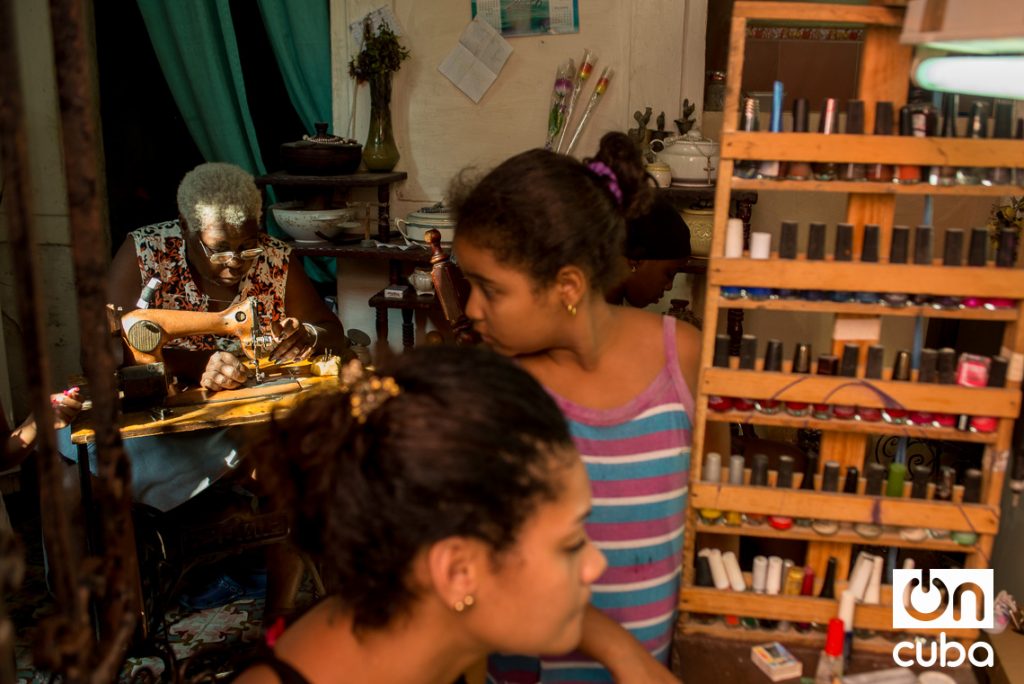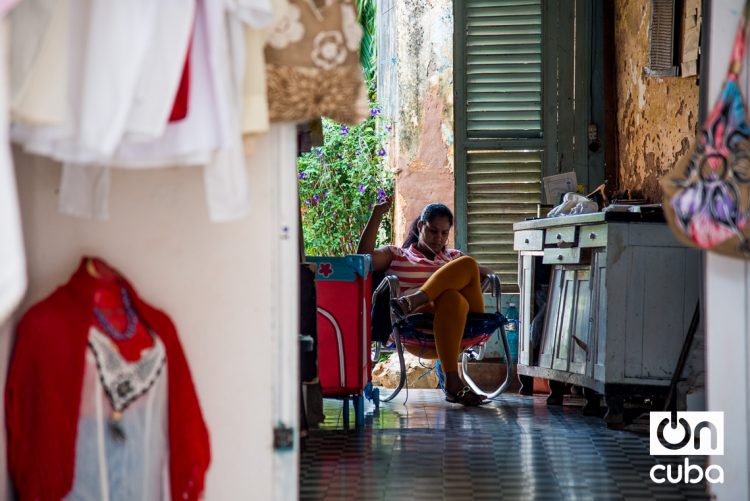Help us keep OnCuba alive here
We present the second part of this dossier that contributes to the open economic debate in Cuba, addressing both foreground issues and some of the least considered. Here, Cuban women economists reflect on the relationship between growth and development, on the need to think about inequalities as part, and not after, of the strategies to confront the crisis, on the regulation of labor rights in the non-state sector of the economy and on gender gaps in the Cuban world of work. Four questions, five voices in counterpoint and complementarity…. They hit on old and new nerves of the Cuban economy and insist that, in order for it to recover, no person can, in effect, be left without protection.
The empowerment of small and medium-sized enterprises is an essential step in Cuba and is one of the emphases that, from different fronts, are trying to be made to confront the crisis. At the same time, it poses socio-political challenges. Two of them are: 1) guarantees of labor rights, which currently function as minimum, fragile and unsafe regulations for hired workers; 2) social inclusion and redistribution policies. How could these issues be part of the debate on the economic model and the expansion of the private sector? Are they issues to consider in this situation or should they be a later debate?
Betsy Anaya: The first major issue regarding this matter is the legitimation of self-employment as private property, as contemplated in the country’s Constitution, approved last year. All the governing documents of the updating process endorse the existence of various types of property, including private property. However, even our statistics include owners and employees in the same category of “self-employed worker” (SEW). But both their strengths to face a situation like the one we are experiencing are very different.
The Ministry of Labor and Social Security has implemented a series of measures to guarantee maximum protection for workers during the pandemic. However, these measures mostly benefit those linked to state employment. The licenses suspended to date correspond largely to employees who have been left without job guarantees or even without employment. The alternative for these people is to request a benefit from the social assistance system, a complex and not very stimulating process given the low amount of this aid.
For self-employed workers, these measures are insufficient. The COVID-19 pandemic has highlighted the vulnerability suffered by people affiliated to this sector. Therefore, it is essential to introduce this debate on the decision-making agenda at this time. From the academia, a proposal has been prepared that includes support variants more appropriate to the reality of the SEW.
Many of our SEWs have been formed in Cuba with values of solidarity and patriotism, and this has emerged with this situation. The Entrepreneurship and Innovation Network and the Public Administration Network, both from the University of Havana, have served as a bridge to channel the availability of a group of entrepreneurs to the municipal governments of the capital to support the authorities in different areas to combat the COVID-19. This shows that in the prosperous and sustainable design of socialism that we have proposed as a country, it is possible and desirable to achieve a virtuous articulation between all the actors in the economy that allows us to achieve that purpose.
Tamarys Lien Bahamonde: What is not mentioned, or is not introduced into public policy from day zero, remains pending and is never resolved. Leaving the debate on social inclusion and distribution out of the empowerment of small and medium-sized enterprises (SMEs) in Cuba would be to go back to the wildest model of economic and social exploitation. I don’t think that should be or is the intention.
There are many ways to include SMEs in a fair socioeconomic project. It can be done through social enterprise models and local development initiatives, in which small entrepreneurs are linked to their communities and contribute to community projects, participate in them, integrate with the community. There are examples of SMEs that have already done so. There is the Artecorte Project, for example, in Old Havana. I have wondered a lot recently why cooperatives have not contributed more and are no longer present in the country. But there are things in economics, as in everything, that cannot be forced. And here I’m referring to the cooperatives that were born in Cuba vertically forced by the people’s powers, from top to bottom, almost all the ones I know have failed.
Cuban labor law has yet to adjust to non-state forms of ownership. I’m going to use my own example to illustrate something. I had a terrible experience working in the Cuban private sector. I worked unlimited hours for six days a week, under a brutal management style. The project was very successful, but the human cost was too high. Years after I left, the workers filed a class action lawsuit against the administration and won it. But there is still a long way to go in that field, such as taxes, which I’m not going to talk about now.
It will be necessary to think about legislation that includes unemployment insurance, fines for violating the 8-hour day. Now, the law is not enough. It must be enforced. The how is where the problem is, and we know it. As long as wages in the state sector continue to be depressed, as long as the Law on Enterprises is not available and only a handful of people can exercise or open spaces for private or collective economic activity, we are increasing the chances that job insecurity will spread in available private spaces.
All measures in this regard must be taken at the same time. Taking some first and waiting for the time to take others considered complementary, is a public policy mistake that, for some reason, we never stop making.
Ileana Díaz: The private sector is a postponed debate. However, it is a debate today, of the Cuban economic model that considers this sector as one more. It is essential that all the actors contribute to the growth and development of the country, much more after this pandemic. The two issues raised, labor rights and social inclusion policies, must be part of the debate to genuinely recognize the private sector.
Blanca Munster: The regulatory framework for SMEs is not a situational issue; it must be understood as a structural element of the economic model that demands incentives, R&D policies, diverse financing mechanisms, and alliances with the public and foreign sector. At the labor level, it is necessary to strengthen the weak mechanisms of labor protection, especially for women, especially young women.
In the SEW and cooperative sector, the ongoing prejudices or stereotypes among their employers regarding women’s lower productivity, social, psychological or physical profile is visible. This generates discrimination and disadvantages when it comes to selecting and hiring personnel and lower income for them.
On the other hand, the social imagery about the obligation of women to carry out work at homes, translates into the tendency to hire them under the eventual modality, part-time, or home work. There are different manifestations of violence against women in the private sector, without having mechanisms to protect their rights.
Anamary Maqueira Linares: The empowerment of SMEs is an essential step that should have been taken long ago and in which the assurance of maximizing their productive potential and minimizing their contradictions must converge. In the midst of the crisis and in need of quick results, this process has more challenges than at previous times.
In terms of labor rights, the granting of legal status to businesses will be a first step, necessary but not sufficient. Once established as enterprises, it will be easier to demand that the sector comply with all the legislation on labor rights. On the other hand, the incentives of the legal, tax, credit, access to inputs framework, etc., must work to be able to adequately conduct the behavior of private businesses. Now, achieving greater social inclusion in the SME sector is possible in two ways: with intentional policies in this regard and based on the effects and earnings they are able to provide in the localities where SMEs are developed.
Finally, I draw attention to the need to strengthen non-state forms in general, including cooperatives, self-managed forms of workers’ control, or others that can be explored and of which, for some reason that we need to debate, there is no talk or little is said.

***
Official statistical data on the non-state sector show a gap in the participation of men and women. While in the state sector there is almost parity, in the non-state sector women represent about 18 percent. In the specific self-employment sector, we are 34 percent. What do you think is the reason for that gap? To what extent can the increased need for women’s participation in wage labor (which ensures them greater economic autonomy) be taken into account in the country’s economic planning for crisis response?
Betsy Anaya: The participation gap between women and men in the non-state sector responds to several factors, ranging from less possession of assets and capital to start their own businesses, to the very sexual division of labor that makes them responsible for non-remunerated domestic work and caregiving.
The country has a significant reserve of labor force in its women. Appropriate incentives and services are needed to enable them to join the work force. The lack of care services for children, the elderly and people with disabilities, for example, means that many women are either not employed or leave their jobs to carry out the role of caregivers. This is influenced by the prevalence of a patriarchal and sexist culture that places them in the tasks of caregiving and reproduction of life. It also implies a trade-off for women between productive and reproductive work.
Many people are convinced that there is a labor shortage in Cuba. However, the economic activity rate of the total population in 2018 was 76.5 percent, while for women it was 49.5. Just over half of the working-age women are not employed or are looking for a job. Added to the above is the high qualification of Cuban women, who since the 1980s are the majority in university enrollments and also in the total amount of graduates.
Economic and social policies for the updating must be articulated to promote the incorporation of women into paid employment, both in the state and non-state sectors. They must also consider the heterogeneity that exists in the “women” group: urban and rural, white and black; heterosexuals and lesbians, among others. Their needs, shortages, living conditions and social recognition are, in part, transversalized by these characteristics.
A framework of support policies is needed that allows them to reconcile productive work with reproductive work. The challenge that I consider more complex is that associated with the transformation of the sexist culture that establishes gender patterns, in which multiple institutions must be involved that are still not clear about the need for such transformation.
Tamarys Lien Bahamonde: There are two steps in the conquest of rights. One is to ensure that rights are expressed in legislation, and the other is to ensure that those rights are expressed in social conduct. Cuba has come a long way in terms of rights and gender equality, in theoretical and to some extent institutional terms. However, much remains to be achieved in cultural matters.
There are elements that worsen the subordinate status of women in economic participation. One of them is the lack of public care services for children and the elderly. To the woman who ―in Cuba and in many places―works outside the home, an equally intense day is added upon returning home. Many times they have to give up higher paying jobs or positions because they require overtime or extra effort they cannot do, for practical reasons. Some―and I know many cases personally―have had to stop working to care for their elderly parents, because they cannot afford private caregivers and don’t want to resort to homes for the elderly, where in general conditions leave much to be desired.
The private sector analysis is interesting. It has two angles. In the first place, any attempt to improve women’s position in the labor market requires a revision and change of authorized private activities. Instead of being authorized, this logic should be changed and those “prioritized by the state” and therefore “not authorized” to be exercised privately should be listed. It would be easier, pragmatic and beneficial for the country. When reviewing the list of authorized activities in the private sector, two things stand out. First, few professions can be practiced privately in Cuba. Second, the activities included are traditionally male, except for a small group (hairdressers, manicures, etc.). If women wanted to join the private sector, in many cases they would have to give up practicing their profession.
The lack of protection in that sector does not help either. The implementation of labor laws would have to extend to maternity benefits, for example, and then we would fall into the paradox of public policy: women would not be hired because they represent a greater risk. This is a very complex subject in the entire world. Cuba won’t be the exception. In any case, you have to start somewhere. Then practice will help us perfect it over time.
Ileana Díaz: According to research, the lower presence of women is due, above all, to the conditions necessary to start a private venture. They have less relational capital and accumulated financial capital than men.
The State, if it understood the need for work in the private sector, should offer incentives so that women have the same conditions as men, but this hasn’t been planned. If the policies focus in this sense, of course it will be necessary to create mechanisms and instruments, institutionalization, so that it is guaranteed.
Blanca Munster: When we analyze the characteristics of the participation of women and men in the state and non-state sectors, we must consider the rates of economic participation, occupation by sector, type of activity, income, labor mobility and other factors.
There are no income statistics disaggregated by sex. Regarding wages, only statistics related to average wages are public. According to official sources from the National Office of Statistics and Information of Cuba (ONEI), in 2018 the average monthly nominal salary in the state sector was 777 CUP and the economic activities with the highest average salaries in the country were: construction (1,539 CUP); exploitation of mines and quarries (1,423 CUP); financial intermediation (1,119 CUP), sugar industry (990 CUP); science and technological innovation (981 CUP); fishing (958 CUP); agriculture and livestock (921 CUP). These are all branches with average salaries above 900 Cuban pesos. As a trend, there is a male majority in these sectors, with the exception of financial intermediation (ONEI, 2019). It can be affirmed, then, that part of the wage differences depends on the sector of economic activity to which a person is inserted, and that, as a trend, men are mainly engaged in those sectors with higher wages.
On the other hand, ONEI data shows that in 2018 the gender gap in labor participation stood at around 27 percentage points: the male economic activity rate (76.9 percent) is higher than that of women (49.5 percent). Inactivity remains feminized and that is even more remarkable in rural areas. There, 64 percent of women are not part of the economically active population. These rural women also have relative disadvantages with respect to their professional training and technical training due to the difficulties they face in reconciling domestic work, education, political participation or other activities. This situation results in that, in general, they participate in paid activities that offer lower incomes and are “traditionally feminine”: confectionery, dressmaking, hairdressing, artisanal, domestic, commercial and service activities. At the same time, they face barriers to their labor promotion options and exercising positions of greater recognition and hierarchy. As long as this situation persists, the slower the cultural changes around the sexual division of labor will be.
Furthermore, one of the main barriers that women face to “start up” is associated with the overload of unpaid domestic work and especially their caregiving responsibilities. The data collected in the two national surveys on the use of time demonstrate this. As a national average, women spend about 14 hours a week more than men in these activities. According to data from the National Survey on Gender Equality in Cuba, domestic overload ranked as the fourth most notable problem for women.
Anamary Maqueira Linares: The gap responds to multiple elements of which there are indications, although the absence of public data in the country greatly limits the analyzes.
Research shows that women have fewer assets, which, in turn, implies that they face greater obstacles when accessing initial capital via credit. On the other hand, it seems that women who receive remittances―another of the access routes to that initial capital―use them more for domestic reproduction and caregiving and not to start businesses.
In these analyzes we have what is called the “selection problem.” In other words, the studies focus on women who are already in the sector and who, despite the obstacles, managed to insert themselves. It would be necessary to see what the reasons are for those who have tried and failed, and even those who would like to insert themselves but cannot.
A lesser considered factor is the relationship between paid work and unpaid work: how, or to what extent, unpaid and caregiving domestic work (of children, the elderly, dependents in general) prevents women from participating in the sector or conditions the way in which they are inserted into wage labor, both in the private sector and in other sectors. Time use surveys show that women are overburdened with domestic and caregiving work. And this is exacerbated by the deterioration of the care infrastructure in the country, the insufficient provision of care services by the State, the high relative costs of care services provided by private individuals, and the challenges of population aging. This situation, which from the feminist economy has been called a “care crisis,” can: condition their participation in wage earning work or lengthen and intensify their total workday, leaving them less time for other tasks related to self-care or leisure.
Without solutions to deal with these issues, it will be very difficult to ensure greater participation of women in wage labor. Without clear strategies to provide such solutions, any development plan will be incomplete.

Coordinator of the dossier:
Postdoctoral researcher at the International Research Group on Authoritarianism and Counter-Strategies (IRGAC) of the Rosa Luxemburg Foundation, associate researcher of FLACSO Ecuador and part of The Future is Feminist Network of the Friedrich Ebert Foundation. Graduated from FLACSO Ecuador (PhD) and from the University of Havana.
Participants:
Candidate for a PhD in Public Policy and Urban Planning from the University of Delaware. Master in Local Development from the University of Camagüey and Bachelor of Economics from the University of Havana.
PhD in Economic Sciences. Senior researcher and Assistant Professor at the Center for Research on the World Economy (CIEM).
PhD in Economic Sciences. Full Professor of the Center for Studies on the Cuban Economy. Coordinator of the Entrepreneurship Network of the University of Havana.
PhD in Economic Sciences from the University of Havana. Full Professor and Director of the Center for Studies on the Cuban Economy of the University of Havana since 2017.
Candidate for a PhD in Economics from the University of Massachusetts, Amherst. Master’s in Development Economics from FLACSO Ecuador and Bachelor of Economics from the University of Havana.
















